The Garden-scene - 'Sisley was here!'
|
THE GARDEN SCENE
with frame

|
THE REVERSE OF
The Garden Scene
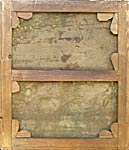
The reverse of "The Garden
Scene". Click above for a larger picture. |
|
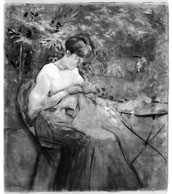
Ir photo |
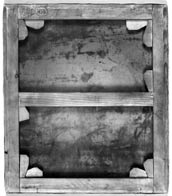
Ir photo |
1)

Sisley, written on the back of
the
Stretcher.
On the stretcher we find a most contradictory
notation. ‘Sisley’ is written in
pencil. Since the style of the painting
has nothing to do with Alfred Sisley, it
took a long time until we learnt why it was written here. This
painting bears a ‘Signature’! At the bottom right corner, we find a
tiny ‘Signature’, under the layer of thin, lilac colour! The
painting was cleaned, and the old varnish was lifted off, without
anybody discovering this writing. It was not found until the
painting was being photographed in black and white.
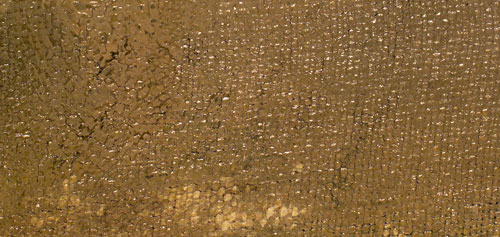
Photo
of Sisley signature
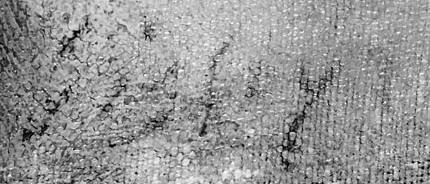
IR photo of
Sisley signature
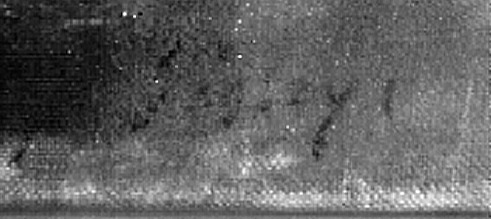
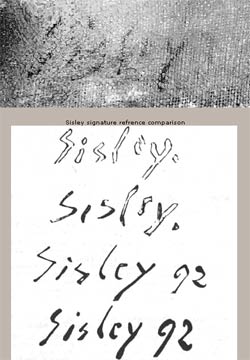
Signature comparison - click
for larger picture
From the beginning it was completely impossible to understand why
the name ' Sisley ' was written on the stretcher. The three
paintings has nothing to do with Alfred Sisley at all - But in one
sensational way!
Alfred Sisley was here and this can never be wisked away!
This is of course extremely mysterious, but nevertheless an
extremely important evidence of the authenticity of all the three
paintings.
At the bottom right corner we have found the tiny, original
Signature of Alfred Sisley!!
Written directly on the canvas and then overpainted by Monet. Now
we can bareley see it covered under the thin lilac colour.
This painting as well as the River-Scene were extremely dirty and
they had never been cleaned or taken out of the frames since they
once were framed, as we believe, in 1899. (Neither had the
Meadow-Scene but it was not as dirty at all.)
The painting was cleaned and the deep brown old varnish was
cleaned away - without anybody discovering the Sisley Signature. It
was not found until we studied a photo taken in black & white.
Imagine what a surprise it was!
But suddenly the writing on the stretcher had got it´s
explanation. So did the mysterious way the canvas was mounted into
the frame.
The Signature was deliberately covered under the frame since
Monet for sure wanted to honour the old friend who once signed the
canvas.
To be able to hide the Sisley-signature they had take a frame,
too small for the picture. Now 5 cm of the painting on the right
hand border was covered by the frame and underneith is now the
Sisley Signature.!
Now is also 'Sisley' written on the stretcher as we can
see it today. Certainly because that what is hidden underneith the
frame must not be forgotten in the future.
The stock-numbers that are written on the other stretchers are
written in the left hand corner, but here Sisley is written in the
corner and the stock-number is later written to the right, showing
that Sisley for sure is written when it was framed.
We shall also bare in mind that when covering 5 cm of the
painting, the very precisely built composition of the painting is
disturbed. Remembering Monet´s pedantry we can easily understand
that this is not done by mere chance.
Click
HERE and we can
easily understand what it means for the composition!
We know that the paintings were taken down from their stretchers
and that they have been lying together in the famoused piles of
unfinished paintings. When Suzanne dies in 1899 they are for certain
saught out and mounted to new stretchers and framed - all at the
same time.
We also know that Alfred Sisley passed away only one month
earlier. What is more natural than Monet decides to save the
signature, as we have seen, as a tribute to the old friend and
fellow artist.
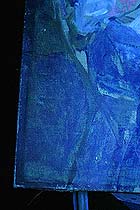
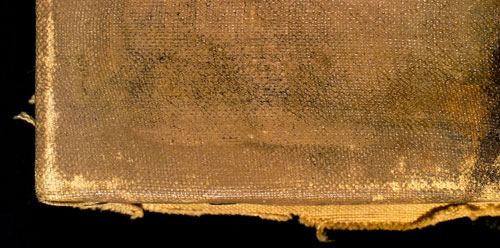

Click HERE picture for pop-up with explanations.
Bottom left corner showing signature partly wiped out.
Lower picture taken in IR light. Click for larger images.
Another Signature!!
In the left bottom corner we can easily see some fuzzy traces in
black looking like if something has been wiped out.
When we lighten up the canvas in UV-light this is clearly beeing
confirmed. Another signature has been taken away when the painting
is still sitting in it´s frame. We know that Claude Monet had his
paintings framed and that he made retouches on them afterwards. When
the painting was framed this also overpainted Signature was
obviously visible much enough to annoy Monet, and it was washed
away.
We handed over the paintings to SKL Statens Kriminaltekniska
Laboratorium, (Forensic Science Laboratory Linköping, Sweden) for
investigation and photo. We are greatful for their efforts and happy
for the excellent photos showing both Signatures and here compared
to three other signatures from around 1886-1892. See signatures
above.
Sisley vs Monet Dreams & Reality
The daily life of the two families was as different as night &
day. We know that the Sisley family with their two children Pierre
and Jeanne were regular visitors at the Monet household.
We also know...
Today we can settle the following facts:
a) All the three paintings are executed by the same
artist.
b) The paintings have been taken away from their
stretchers and put into a pile together with other paintings.
Probably because of the death of Suzanne they are saved from
destruction and tacked on new stretchers and framed by the same
hand. The stretchers have not been used before and this also gives
full evidence for the fact that the figures written on them really
refer to these paintings.
c) We have TWO SISLEY SIGNATURES - in
the bottom left corner wiped out on the surface, (uv-photo), but
preserved under the paint-layer, (IR-photo). In the bottom right
corner - still possible to see and untouched under the thin paint
layer. But today delibarately covered by the frame like a:
Closed Archaeological Find from around 1886.
This is extremely important. No one can deny that these
signatures really exist. UV-light gives evidence for the fact that
the whole painting is untouched since it was varnished except the
left hand corner with the washed away signature which shows
separation. We have also seen that this is done AFTER the the
painting was framed - with the canvas still in the frame. Most
probably in 1899, 13 years after it was painted.
The old friend Alfred Sisley has died as well as now Suzanne. The
other Signature is preserved - you could even say 'buried' under the
frame and the stretcher becomes a Tombstone with his name written on
it. A fascinating symbolic and artistic act by Claude Monet worthy
this old friend Alfred Sisley.
We have also seen that the signatures were written directly on
the canvas and then overpainted by Claude Monet.
(To see the UV-light Photo - Click HERE).

To see the UV-light Photo - Click picture
d) The preserved Signature is exactly the hand-writing of
Alfred Sisley, written in the same manner as he signs 1885-92.
e) Two Sisley Signatures which no-one can deny that they
really exist and that they are genuine and original.
How can we explain their existence? We assume that they are a
small Practical Joke by Alfred Sisley - though a little tragic as
well.
Deceased in 1899, without having obtained any
greater recognition as a painter and in addition a s
a broken man. And furthermore: Who should
wipe out one signature and keep the other?
(See: Stuckey: ‘Claude Monet 1840-1926’, The Art Institute of
Chicago 1995, p.231: 1899, May 1. Benefit auction for
Sisley’s children held at the Georges
Petit Gallery, Paris, thanks largely to Monet’s efforts. He donates
‘Sandvika’, Norway, to the benefit, the
first of the Norway works to be offered for sale. The auction
disperses the contents of Sisley’s
studio. Purchasing a painting for himself, Monet keeps the bidding
active.”).
Alfred Sisley never had any success
as an artist during his lifetime. Nobody else would have any
interest in writing his name.
Monet had tremendous success. He is
also the one who wipes it out - or more possibly gives the order to
have it taken away.
But he also gives the order to
preserve the other signature!
The hidden Signature is certainly
not covered by coincidence. On the contrary it is most deliberately
done with negatif effect on the composition of the painting, by
putting the canvas into a too small frame, of which a back lath is
cut away to make it possible. (Click
HERE to se the composition and
how the back of the frame.)
The writing of Sisley on the
stretcher as a reminder. It is easy to see all this even as a
symbolic treatment.
Seen from the Sisley point of view
this small joke and happening of his will give an echo in the world
140 years later and be the definite evidence that three paintings by
his best friend Claude Monet will be identified as the Master-pieces
they really are and this thanks to no one but Alfred Sisley!!
2)
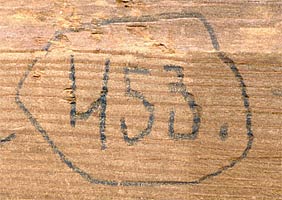
Stock numbers like the others, written in pencil
on the stretcher: ‘453 followed by a dot,
within a circle’.
What do these stocknumbers tell us? Of course that the paintings
were sold to the same dealer. At two different times. Two? That´s
it. The numbers 453 and 454, the number of the M.S., make it clear
that these two were sold at the same time. Evidently this unknown
dealer still had the Riverscene, though it must have been quite a
long time ago since he bought it. To be exact – it was 116 paintings
ago – certainly at least a year earlier.
It certainly is mysterious that the paintings still remain
together. There might be a possible explanation – Suzanne – she is
the link between the three paintings and a possible reason of
that they still stick together. Could it be that the person who sold
them, probably a relative to Suzanne, regretted having sold them and
exchanged them against another painting. We don´t know, but it
really is remarkable that they still belong together. Don't you
think so?
3)
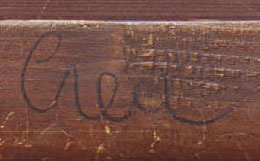
Written on the frame in pencil:
‘Creu’. See “Meadow scene”
further on for more information.
4)
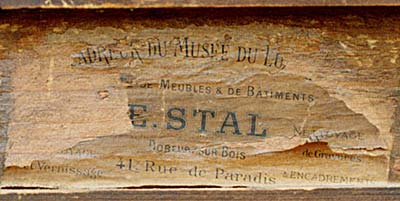
E.Stal, Encadreur Du Musée Du
Luxembourg
Label of the frame maker: ‘E.Stal,
Encadreur Du Musée Du Luxembourg’. This frame is a fine
piece of craftsmanship, see photo of detail.
5)
It is remarkable that this
canvas was varnished while still remaining in the frame. This is why
the borders and the right part of the canvas, hidden under the
frame, still have the original linen colour. The white (!) inner
border was also partly covered with varnish. This varnish has turned
brown today, in the way we have seen on the canvas.
In my opinion no dealer should
ever have varnished a painting in its frame, (and certainly not
hidden 10 cm of the right part), while the risk is obvious to
damage the white border. Monet however practiced the habit
retouching his paintings in their frames. Perhaps this painting had
suffered from its violent ’storage’ and the paint surface must also
have been damaged after the Sisley signature had been washes off.
Monet chose to varnish it for a better finish. We know that the
intention was that his paintings should remain unvarnished. We also
know that almost every impressionist painting has been varnished,
perhaps not always by dealers but also by Claude Monet himself.
Remarkable is also how even
this frame was ’modernized’ - again the white inner border was
originally gilt! The gilt has even here been rubbed off for a
modern ’Impressionist Look’ – exactly like it was rubbed off from
the frame of The River Scene as well.
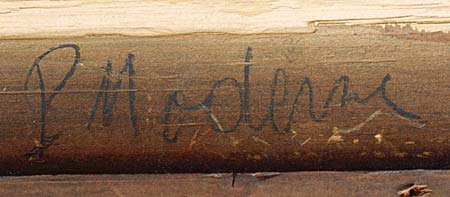
P Moderne ,
Observe how the support edging has been cut away.
Written on the frame in pencil: ‘P
Moderne’, already mentioned above,
see under ‘River scene’ no 5. In this photo we can also see how the
frame was altered, to make the canvas fit properly.
6)
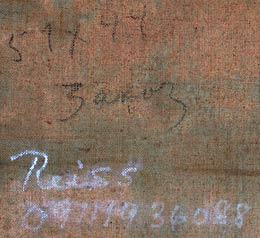
Click for larger image
Measure figure written on the canvas, like on
the other two, ‘51x44’.
Here is also something else written, unfortunately we are not able
to read and understand what it
means - do you? Picture taken in UV light. Also showing secret name
and personal number for Einar Reiss (The former owner).
Press HERE for next
page
|